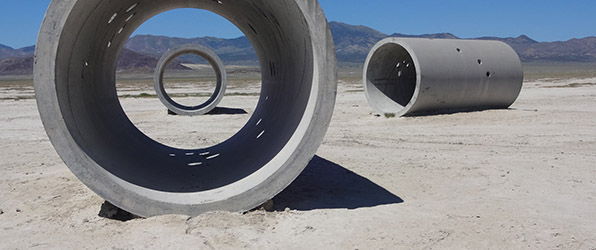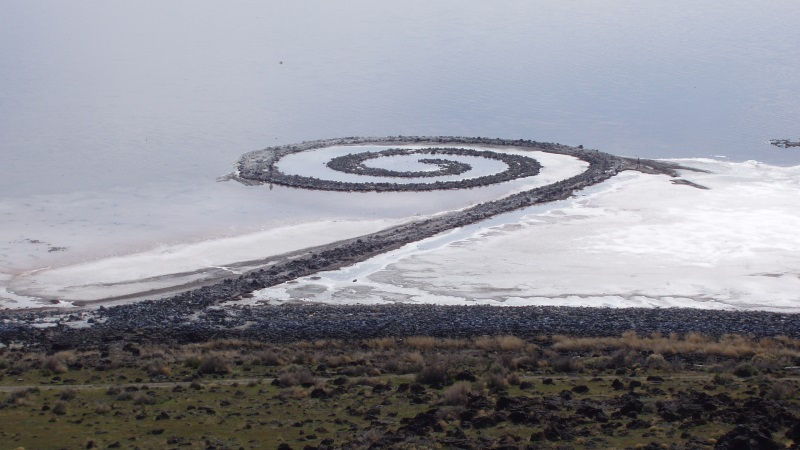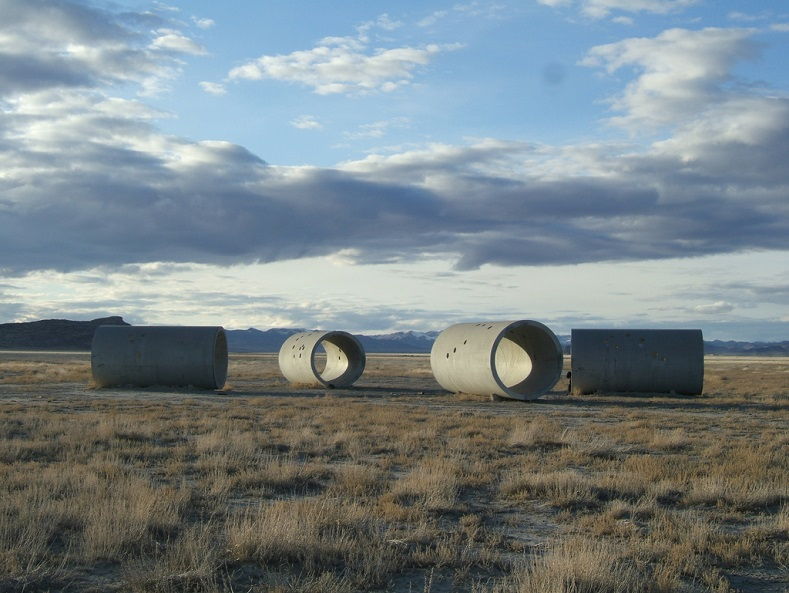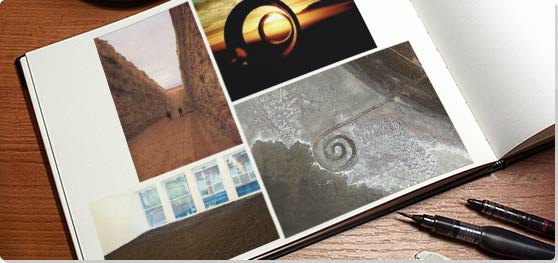Summary of Earth Art
Earth art, also referred to as Land art or Earthworks, is largely an American movement that uses the natural landscape to create site-specific structures, art forms, and sculptures. The movement was an outgrowth of Conceptualism and Minimalism: the beginnings of the environmental movement and the rampant commoditization of American art in the late 1960s influenced ideas and works that were, to varying degrees, divorced from the art market. In addition to the monumentality and simplicity of Minimalist objects, the artists were drawn to the humble everyday materials of Arte Povera and the participatory "social sculptures" of Joseph Beuys that stressed performance and creativity in any environment.
Key Ideas & Accomplishments
- The favored materials for Earthworks were those that could be extracted directly from nature, such as stones, water, gravel, and soil. Influenced by prehistoric artworks such as Stonehenge, Earth artists left their structures exposed to the elements. The resulting ephemerality and eventual disintegration of the works put them outside of the mainstream where works of art were typically coddled and protected in controlled environments.
- Earth artists often utilized materials that were available at the site on which their works were constructed and placed, honoring the specificity of the site. Locales were commonly chosen for particular reasons. Robert Smithson, for example, picked damaged sites for his works in order to suggest renewal and rebirth. This idea of site-specificity was something introduced to the art world by Earth art, again placing the artists at the vanguard because their pieces often required wide, open spaces, meaning that many of their works were not available to the average viewer and thus questioned the very purpose of art as something to be viewed.
- The rejection of traditional gallery and museum spaces defined Earth art practice. By creating their works outside of these institutions, Earth artists rebuffed the commodity status these venues conferred on art, again challenging traditional definitions of art as something to be bought and sold for profit.
Overview of Earth Art

"In my Land art dealing with astronomical phenomena, I am putting 'centers of the universe' wherever I go," Nancy Holt said. Her Sun Tunnels in the desert of Utah were meant, she said, "to make people conscious of the cyclical time of the universe."
Artworks and Artists of Earth Art
A Line Made By Walking
Made while Richard Long was a student in London, A Line Made By Walking documents a work he created as he walked back and forth across the same path in Wiltshire. Here, Long emphasizes the experiential factor of nature through the act of walking and the temporal factor involved in artistic practice, while also having an impact on the land. The subject matter is the interaction of the journey, marking the ground, and making a simple adjustment to the landscape. With its simple, geometric shape and minimal intervention on the site, the work is also reminiscent of - and perhaps influential to - later Minimalist works such as Richard Serra's To Encircle Base Plate Hexagram, Right Plates Inverted (1970). Like most Earthworks, the piece is site specific and ephemeral. The photographs document the work's temporary existence, but do not solely constitute the work itself. While the photographs simply mark the performance of the work, the documentation process was sometimes important to artists working in Earth art, as it was often the only way to evidence the creation of the work. The work was groundbreaking in its utter simplicity and ephemerality as it would have been invisible within hours or days as nature would have taken its course, thus also making the piece useless as a commodity object.
Documentation of performance
Double Negative
In 1969, with financial assistance from Virginia Dwan, Michael Heizer began this massive work that cut 240,000 tons of rhyolite and sandstone from cliffs to create two trenches on the eastern edges of the Mormon Mesa, northwest of Overton, Nevada. As few could visit the site after the work's completion, Heizer documented the production of the work in photographs and exhibited them at the Dwan Gallery in New York. With Double Negative, Heizer enacts a heroic gesture by removing earth from its site, forcing a contemplation of the manmade processes that constitute the artwork and the natural, physical elements that exist outside of it. He places Double Negative directly in the context of art history and architecture, touching upon megalithic ancient monuments as well as modern feats of engineering in the industrial age. Although the work required a great deal of labor, it consists of negative space; it is basically a 1,500-foot-long canyon into which a viewer would enter to be surrounded on three sides by 50-foot walls of earth. Its site-specificity and remoteness are typical of Earth art, as few viewers would be able to visit it. Its presence in the open air of the desert also means that it is subject to the environment and will eventually disintegrate. Connecting the work to Minimalism is its simplicity of design, the importance of the kinesthetic response of the viewer to its meaning, and its monumental size that was meant to overwhelm the spectator, which, much like Ronald Bladen's X (1967-68), makes them feel their smallness within the immensity of nature (and the work of art).
Two trenches dug out in the Mormon Mesa

Spiral Jetty
Realized in April 1970, Robert Smithson's Spiral Jetty is one of the most recognizable works from the Earth art movement. Smithson constructed a 1,500-foot-long and fifteen-foot-wide spiral made of stones, algae, and other organic materials (6,000 tons in all) in the northeastern part of Utah's Great Salt Lake. The Ace Gallery of Vancouver and Dwan financed an earth-moving company to create the spiral out of basalt rock and earth from the surrounding area. In 1972, when the water level rose, the work became submerged. Thirty years later, as the lake's water levels changed, Spiral Jetty became visible again, revealing the basalt rock crusted over with white salt. The work was inspired by the Pre-Columbian structure Serpent Mound, which Smithson had seen on a site visit in Ohio. Spiral Jetty and Smithson's body of work as a whole were typical of Earth art in their protest against the commodification of the art market since it was impossible to buy or sell the work. The physical mutability and even invisibility of the work resulting from natural processes, such as water currents and erosion, were essential to its meaning. As a work of art that was not only remote, but also at times impossible to view because of the forces of nature, Spiral Jetty is one of the best examples of Earth art and also underscores the movement's roots in Conceptualism.
Basalt rock, limestone, earth, and algae configured in a spiral off the shore of the Great Salt Lake

Sun Tunnels
Positioning four gigantic concrete hollow cylinders, each measuring nine feet in diameter, Nancy Holt arranged her tunnels at precise geographical points to correspond with the sunrise and sunset during the summer and winter solstices, much like Stonehenge. Fascinated by astronomy, Holt punctured the cylinders with holes of differing sizes to create shadows of select constellations. Like some other Earth artists, Holt had a significant interest in science and ecology, actively informed by her undergraduate work at Tufts University. Sun Tunnels closely examines the physical qualities of perception, marking accurate positions of the sun on the horizon and allowing light to filter through the starry holes according to the position of available light. Holt created preparatory light works on paper, which captured the play of sunlight in two- and three-dimensional models. Her research-based practice and interest in remote locales connected Holt not only to other artists working in this mode, but also to the Conceptual interest in the intersection of art and ideas. The work is not meant to disintegrate as the majority of Earthworks, but it draws attention to the details of nature in a site-specific and remote locale.
Four 18 foot concrete cylinders
The Lightning Field
This work consists of 400 poles that are each set 220 feet apart in a grid format. The height of the piece varies from 15 to 26 feet depending on the level of the land. While the highly polished poles are meant to visually mark the undulations of the landscape, their primary function is to attract lightning, especially during lightning storm season in late summer when lightning strikes the rods and illuminates the installation. De Maria's use of a precise grid format is drawn from Minimalism, but the viewer's experience will depend on a number of environmental factors outside of the artist's control. For example, the work's visual impact is based on fluctuations in weather and the change of seasons; the piece would lose much of its attraction at times of the year when lightning is infrequent. As with most Earthworks, the site is remote and viewing is made more difficult by the requirement for viewers to stay overnight at cabins on site; no children are allowed. Much like Nancy Holt's Sun Tunnels, De Maria's work pairs fleeting moments of nature with the heroic materials of manmade industry.
400 stainless steel poles arranged in a grid measuring 1 x 1 km
Wheatfield
Denes and her assistants cleared the Battery Park landfill and planted nearly two acres of golden wheat. The planting cycle was completed between May and August of that year, and the process involved establishing an irrigation system, weeding, fertilizing, and protecting the wheat from mildew. After much tending, one thousand pounds of wheat was eventually harvested and traveled around the world in the exhibition "The International Art Show for the End of World Hunger," which highlighted larger issues of human struggle inherent in agriculture and land use as well as the uncomplicated pleasures of nature.
Two acres of wheat planted in the Battery Park landfill
Pebbles, broken and scraped white with another stone
Like his fellow countryman, Richard Long, Andy Goldsworthy seeks to establish a temporal relationship in his work. Goldsworthy manipulates nature, reworking organic materials such as stone, branches, flora, water, and snow to create fleeting impressions in a natural setting. The seemingly "final" work is recorded through documentation, but the process and the eventual disintegration of the work inform its status as well. The title of this work, Pebbles, broken and scraped white with another stone, dutifully explains the process by which the work was created, the materials that were used, and the physical properties of the work. Although Goldsworthy has documented an artwork, the work will eventually erode and lose its status as art through the passage of time. As with the work of all Earth artists, Goldsworthy's work questions the relationship that humans have with history, time, landscape, and natural processes.
Beginnings of Earth Art
Extending Minimalist and Conceptual Ideas
The late 1960s and 1970s was one of the most experimental periods in the history of Western art with many concurrent movements and artists working simultaneously in more than one style, making it sometimes difficult to definitively attach stylistic labels to works from the period. The ethos of Earth art, for example, shared certain characteristics with Minimalism, including its concerns with how objects occupied their space; the interaction of humans with works of art; and, especially, simplicity of form. However, although the adoption of the pared down Minimalist aesthetic was often central to Earth art, the artists were typically hands-on with the documentation and process of production, at times even including a performative element; these characteristics aligned Earth artists more with Post-Minimalist tendencies such as process art, installation art, and performance Art. Earthworks, largely existing outdoors and made of natural elements, were also subject to the natural degradation and erosion that would occur with time, which was antithetical to Minimalism's more industrial and urban aesthetic, making it one of the most unique elements of the Earth art movement.
Like Conceptual art, Earth art was not just about the beauty and aesthetic pleasure offered by the artwork. Almost all Earthworks stressed the rejection of commodity status and mainstream exhibition venues, focusing instead on ephemerality. So while the majority of Earth art was visually stunning, at its core, the pieces were imbued with these concepts.
The 1960s and Virginia Dwan
Earth artists were typically products of the Vietnam era, many of whom had been drafted to fight in the war and were college educated through the G.I. Bill. Most, like Robert Smithson and Michael Heizer, began their careers as painters. Smithson's first paintings evolved from figurative abstractions to geometrical canvases, and then eventually to sculpture. In 1966, Smithson began showing with the influential gallerist Virginia Dwan, who would shape the Earth art movement significantly.
At the same time, Smithson began working as a consultant for a New York City engineering firm, a position that inspired him to plan what he called "Aerial Art" for the Dallas Fort Worth airport. Aerial Art comprised monumental works to be constructed between airport runways that were meant to be viewed from above during takeoff and landing. As an art form, Aerial Art never came to fruition, but Smithson and his colleagues, such as Carl Andre, Nancy Holt, Robert Morris, and Michael Heizer, were inspired by the idea to explore various unexploited territories in nearby New Jersey and in various western states that provided large, open spaces.
Dwan, who was the heiress to the Minnesota Mining & Manufacturing Company (3M) and had studied art, often accompanied artists to far-flung sites and provided generous patronage and support to produce Earth art projects that would have foundered with no funding. In 1968, Dwan exhibited a show entitled Earth Works at her gallery space in New York City, publicly identifying a group of pioneering artists. Some of the artists in the show were having a difficult time finding available land for their site-specific projects, so Earth Works exhibited the documentation of these projects by artists such as Sol LeWitt, Robert Morris, Claes Oldenburg, Dennis Oppenheim, and Stephen Kaltenbach. The show cataloged the conception of their work through maps, photographs, transparencies, and drawings. There is some irony in the fact that while these artists tried to eschew traditional institutions, they were often required to accept funding from them in order to further their projects. In addition, the remoteness of certain sites, many of which could only be viewed from private aircraft, meant that the movement was sometimes accused of elitism.
Institutional Exhibitions and Global Ambitions
In February of 1969, the Herbert F. Johnson Museum of Art at Cornell University became the first American museum to show an exhibit of Earth art, entitled simply, Earth Art. The works were displayed both at the museum and throughout the grounds of Cornell's campus in Ithaca, thus providing an institutional setting for works that would continue to question the commodity status of art, particularly those works placed on the campus which served to blur boundaries between the object and its context. Curated by Willoughby Sharp, an independent scholar and cofounder of the avant-garde art magazine Avalanche, Earth Art exhibited new works created onsite by American artists such as Robert Smithson, Robert Morris, Michael Heizer, Walter De Maria, and Dennis Oppenheim. International artists such as British artist Richard Long and German artist Hans Haacke were also included. The 1970s would usher in a new decade of extremely ambitious projects in far-flung American locales, further expanding the American contribution to Earth art.
Earth Art: Concepts, Styles, and Trends
Site-specificity and Environmentalism
Smithson delineated the concepts of "Site" and "Nonsite" to designate theoretical differences in the physical context of work produced. "Nonsite" was termed as an "indoor earthwork" and indicated a piece that could be exhibited in a gallery setting, displacing natural materials from their original sites with accompanying drawings or photographs. "Site" referred to those works created outside the gallery infrastructure in site-specific locales with materials taken from that location. Smithson's iteration of these new frameworks along with the activist mentality of the late 1960s underscored the interest of some Earth artists in socially engaged art that explored humans' relationship with the land (soon evolving into the related, but independent Environmental Art movement). For many artists, this was a conscious movement away from Greenbergian modernism that instead stressed art's lack of connection to the mundane world.
Decay
Earth artists were influenced by prehistoric and ancient monuments such as Stonehenge and Native American burial mounds that were monumental in size and scale. Heizer experienced these prehistoric sites firsthand as a child, visiting various excavations with his father, who was an archaeologist. The prehistoric monuments, by means of their continued existence incorporated the passage of time through natural decay and erosion. The entropy of the materials, which were both manmade and organic, was integral to Earthworks. The pieces created outdoors by the likes of Smithson and Heizer were naturally subjected to the depredations of the elements so that decay and disintegration were part of their meaning; preservation was understood as a conceit.
Invasive and Non-invasive
Earthworks are sometimes divided into those works that make great changes to the landscape and those that do not. Works in the former category generally require earth-moving equipment to make massive alterations to a site, such as Robert Heizer's Double Negative (1969-70). Those works that are non-invasive and are seen as more respectful to the land include Richard Long's A Line Made by Walking (1967), along with pieces by Andy Goldsworthy and Alan Sonfist.
Later Developments - After Earth Art
During the mid-1970s, the recession impacted the funding of Earth art dramatically. Many artists were dependent on patrons to purchase expensive tracts of land to complete large-scale work. In addition to the economic slump, Robert Smithson's sudden death in 1973 while surveying possible sites in Texas changed the momentum of the movement. Those who established their names through Earth art, such as De Maria, Heizer, Morris, and Andre, took their careers in other directions, reorienting their production to accommodate institutional and gallery spaces. De Maria's New York Earth Room (1977) was executed in 1977 and several international iterations were created. Heizer would also create gallery-appropriate works, reconfiguring notions of site-specificity to adapt to art world institutions. Along with other postwar Conceptual artists, Earth artists ushered in a new period of art that favored installations over discrete objects, challenging the expectations of artistic production.
The tenets of Conceptualism became dominant in the art world during this period, as many movements began to share ideas and encourage artists working in multiple institutional frameworks. Post-Minimalist movements such as Process art were strongly connected to Earth art, and many artists working between the movements would shift towards the gallery model as the economy weakened and cheap alternative spaces became available in urban locales. Conceptual art also ushered in an era of performance that translated well in gallery settings and, like Earth art, challenged traditional notions of art as a commodity because of its transitory nature. Organic materials were sometimes utilized within the gallery space, and an emphasis on the ephemeral was understood through site-specific and temporary installations.
Useful Resources on Earth Art
- Ends of the Earth: Land Art to 1974Our PickBy Philipp Kaiser, Miwon Kwon, Tom Holert, Julian Meyers, Emily Scott, and Jane McFadden
- Art & Place: Site-Specific Art of the AmericasOur PickBy Editors of Phaidon
- Land and Environmental ArtOur PickBy Jeffrey Kastner and Brian Wallis
- Earthworks and Beyond: Contemporary Art in the LandscapeBy John Beardsley
- Land ArtBy Gilles Tiberghien
- Art Nature Dialogues: Interviews with Environmental ArtistsBy John K. Grande and Edward Lucie-Smith
- Destination ArtBy Amy Dempsey
- Robert Smithson: The Collected WritingsOur PickBy Robert Smithson and Jack Flam
 Ask The Art Story AI
Ask The Art Story AI























